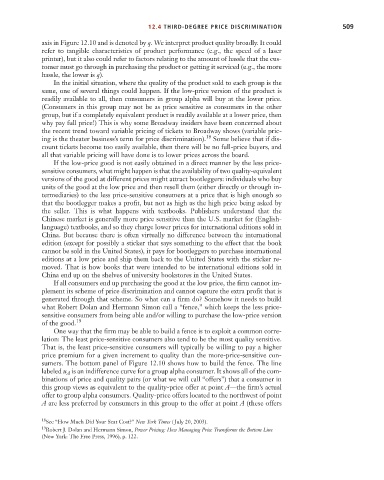Page 535 - Microeconomics, Fourth Edition
P. 535
c12capturingsurplus.qxd 7/22/10 10:41 AM Page 509
12.4 THIRD-DEGREE PRICE DISCRIMINATION 509
axis in Figure 12.10 and is denoted by q. We interpret product quality broadly. It could
refer to tangible characteristics of product performance (e.g., the speed of a laser
printer), but it also could refer to factors relating to the amount of hassle that the cus-
tomer must go through in purchasing the product or getting it serviced (e.g., the more
hassle, the lower is q).
In the initial situation, where the quality of the product sold to each group is the
same, one of several things could happen. If the low-price version of the product is
readily available to all, then consumers in group alpha will buy at the lower price.
(Consumers in this group may not be as price sensitive as consumers in the other
group, but if a completely equivalent product is readily available at a lower price, then
why pay full price!) This is why some Broadway insiders have been concerned about
the recent trend toward variable pricing of tickets to Broadway shows (variable pric-
ing is the theater business’s term for price discrimination). 18 Some believe that if dis-
count tickets become too easily available, then there will be no full-price buyers, and
all that variable pricing will have done is to lower prices across the board.
If the low-price good is not easily obtained in a direct manner by the less price-
sensitive consumers, what might happen is that the availability of two quality-equivalent
versions of the good at different prices might attract bootleggers: individuals who buy
units of the good at the low price and then resell them (either directly or through in-
termediaries) to the less price-sensitive consumers at a price that is high enough so
that the bootlegger makes a profit, but not as high as the high price being asked by
the seller. This is what happens with textbooks. Publishers understand that the
Chinese market is generally more price sensitive than the U.S. market for (English-
language) textbooks, and so they charge lower prices for international editions sold in
China. But because there is often virtually no difference between the international
edition (except for possibly a sticker that says something to the effect that the book
cannot be sold in the United States), it pays for bootleggers to purchase international
editions at a low price and ship them back to the United States with the sticker re-
moved. That is how books that were intended to be international editions sold in
China end up on the shelves of university bookstores in the United States.
If all consumers end up purchasing the good at the low price, the firm cannot im-
plement its scheme of price discrimination and cannot capture the extra profit that is
generated through that scheme. So what can a firm do? Somehow it needs to build
what Robert Dolan and Hermann Simon call a “fence,” which keeps the less price-
sensitive consumers from being able and/or willing to purchase the low-price version
of the good. 19
One way that the firm may be able to build a fence is to exploit a common corre-
lation: The least price-sensitive consumers also tend to be the most quality sensitive.
That is, the least price-sensitive consumers will typically be willing to pay a higher
price premium for a given increment to quality than the more-price-sensitive con-
sumers. The bottom panel of Figure 12.10 shows how to build the fence. The line
labeled u is an indifference curve for a group alpha consumer. It shows all of the com-
A
binations of price and quality pairs (or what we will call “offers”) that a consumer in
this group views as equivalent to the quality-price offer at point A—the firm’s actual
offer to group alpha consumers. Quality-price offers located to the northwest of point
A are less preferred by consumers in this group to the offer at point A (these offers
18 See “How Much Did Your Seat Cost?” New York Times ( July 20, 2003).
19 Robert J. Dolan and Hermann Simon, Power Pricing: How Managing Price Transforms the Bottom Line
(New York: The Free Press, 1996), p. 122.

